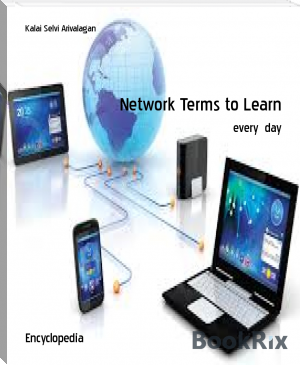Network Terms to Learn - Kalai Selvi Arivalagan (best love novels of all time .TXT) 📗

- Author: Kalai Selvi Arivalagan
Book online «Network Terms to Learn - Kalai Selvi Arivalagan (best love novels of all time .TXT) 📗». Author Kalai Selvi Arivalagan
Bitcoin (BTC)
Bitcoin is a digital cryptocurrency made up of processed data blocks used for online and brick-and-mortar purchases. Because bitcoins are limited and their value is determined by market forces, bitcoins are also traded like stocks on various exchanges. Relatively new and experimental, bitcoin is described as “the first decentralized digital currency.”
Whaling
Whaling is a specific kind of malicious hacking within the more general category of phishing, which involves hunting for data that can be used by the hacker. In general, phishing efforts are focused on collecting personal data about users. In whaling, the targets are high-ranking bankers, executives or others in powerful positions or job titles.
Artificial Intelligence Robot
Artificial Intelligence Robot or AIBO is a name for a Sony product developed as a robotic pet. Multiple instances of this product line are available in the United States, although they come with price tags of up to several thousand dollars. The AIBO uses an Open-R modular platform to create a life-like interface including voice recognition, machine learning and the ability to respond to stimulus.
Heuristic Programming
Heuristic programming approaches the idea of artificial intelligence by solving problems using experience-based rules or protocols.
Programming Logic
Programming logic is a fundamental construct that's applied to computer science in a variety of comprehensive ways. Programming logic involves logical operations on hard data that works according to logical principles and quantifiable results.
Hand Coding
Hand coding involves writing functional code or layout directions in the basic languages in which they are compiled. The alternative is to use various kinds of tools to implement coding conventions without having to hand code them in the original languages.
Node
A node is a point of intersection/connection within a data communication network. In an environment where all devices are accessible through the network, these devices are all considered nodes. The individual definition of each node depends on the type of network it refers to. For example, within the physical network of a smart home domotics system, each home appliance capable of transmitting or receiving information over the network constitutes a node. However, a passive distribution point such as a patch panel would not be considered a node.
Nodes create, receive and communicate information and store it or relay it to other nodes. For example, a scanner in a computer network creates images and sends them to a computer, while a router organizes data received from the internet and distributes it to the individual devices within the network. The concept of nodes works on several levels, but the big-picture view defines nodes as the major centers through which internet traffic is typically routed. This usage is somewhat confusing, as these same internet nodes are also referred to as internet hubs.
Term of the day - 21 Cloud-in-a-Can
A cloud-in-a-can is a single product that allows a company to deploy a private virtual environment protected by a firewall. Cloud-in-a-can products are intended to reduce the costs of setting up cloud infrastructure. Cloud-in-a-can solutions are usually a combination of software and the hardware needed to run it properly. Cloud-in-a-can solutions are also referred to as cloud-in-a-box.
Virtual Internet Service Provider
A virtual Internet service provider (VISP) is an Internet service provider company that offers Internet services under another brand name, allowing customers to access the Internet through multiple points of presence (POPs). Virtual ISP is also known as wholesale ISP or affinity ISP because the POPs used by the VISPs are controlled and managed by the wholesale ISP.
Cognitive Security
Cognitive security is the idea of utilizing artificial intelligence to improve digital security systems. Bringing AI to the security world is expected to improve comprehensive security a great deal in systems that are otherwise vulnerable to a wide range of threats from hackers and other malicious actors.
Internet of Everything
The Internet of Everything (IoE) is a broad term that refers to devices and consumer products connected to the Internet and outfitted with expanded digital features. It is a philosophy in which technology's future is comprised of many different types of appliances, devices and items connected to the global Internet. The term is somewhat synonymous with the Internet of Things (IoT).
Cloud-Based Point of Sale
Cloud-based point of sale (cloud-based POS) is a type of point-of-sale system where information for transaction processing comes from a remote cloud service. In general, POS refers to the place where purchases happen, for instance, at a cashier�s kiosk or at a hostess desk (or side table) at a restaurant.
Data Exhaust
Data exhaust refers to the data generated as trails or information byproducts resulting from all digital or online activities. These consist of storable choices, actions and preferences such as log files, cookies, temporary files and even information that is generated for every process or transaction done digitally. This data can be very revealing about an individual, so it is very valuable to researchers and especially to marketers and business entities.
Hidden Markov Model
A hidden Markov model (HMM) is a kind of statistical model that is a variation on the Markov chain. In a hidden Markov model, there are "hidden" states, or unobserved, in contrast to a standard Markov chain where all states are visible to the observer. Hidden Markov models are used for machine learning and data mining tasks including speech, handwriting and gesture recognition.
Zombie VM
A zombie VM is a virtual machine that is not functioning properly in a software environment, but continues to operate, sucking up resources and providing no value.
Van Eck Phreaking
Van Eck phreaking is a form of digital espionage whereby an eavesdropper detects and analyzes digital signals using equipment that can pick up the electromagnetic emissions put out by a cathode ray tube (CRT) or LCD display. This makes it possible for someone to read the images on another person's display from a distance. There are ways to obscure or reduce display emission in order to thwart Van Eck phreaking, but they are not commercially viable because the security risk that Van Eck phreaking poses to the general public is considered to be very small. This is because Van Eck phreaking requires specialized knowledge and decoding equipment that is not widely available. Highly sensitive computer networks do, however, use Faraday cages to prevent any possibility of a breach via Van Eck phreaking.
Virtual To Physical
Virtual to physical (V2P) is the process of converting or porting a virtual machine (VM) onto and/or as a standard physical machine. V2P allows a VM to transform into a physical machine without losing its state, data and overall operations. Virtual to physical is also known as virtual to physical migration (V2P migration).
Synchronous Learning
Synchronous learning refers to a form of education, learning or instruction in which the student learns from the instructor in real time but not necessarily in person or in the same place. The most basic example of synchronous learning is the classroom environment, but now e-learning alternatives have become available. E-learning is often done via a teleconference or video conference over a network such as the Internet, and it can take the form of one-on-one tutorials and even online seminars, often called webinars.
Nanofabrication
Nanofabrication refers to the design process of nanomaterial and devices that are measured in nanometers. One nanometer is one millionth (10-9) of a meter. Nanofabrication helps in parallel processing of material over a large scale. It is a cost-effective method whereby large-scale economy is manufactured using the same machinery and design and small amount of material.
Brain-Computer Interface
A brain-computer interface (BCI) is a technology that allows communication between a human or animal brain and an external technology. This term can refer to an interface that takes signals from the brain to an external piece of hardware, or a technology that sends signals to the brain. Various different brain-computer interface technologies have been developed at different times, through different methods and for diverse purposes, including in virtual reality technology. A brain-computer interface may also be known as a brain-machine interface, a direct neural interface, or a mind-machine interface.
Machine-Oriented High-Level Language
Machine-oriented high-level language (MOHLL) refers to any machine language that has the capabilities of a high-level programming language. Machine-oriented high-level language provides the typical features of a low-level language along with the advanced statement and program control features found in high level languages. Machine-oriented high-level language is related to advanced versions of assembly language. Machine-oriented high-level language primarily enables building programs in assembly language or machine language to gain more control over the underlying hardware architecture.
Collaboration Data Objects
Collaboration Data Objects (CDO) is an application programming interface (API) built into Microsoft Server products. CDO provides access to the global address list, mailbox content, public folders and other server objects related to messaging and Microsoft Outlook. CDO cannot be used to directly program added functionality to MS Outlook. The function library of CDO gives developers a convenient way to create, manipulate and send Internet messages, which is not possible with applications such as Microsoft Outlook. Collaboration Data Objects was previously known as OLE Messaging or Active Messaging.
Machine-Generated Data
Machine-generated data are information that is the explicit result of a computer process or application process, created without human intervention. This means that data manually entered by an end-user are definitely not considered as machine-generated. These data cross all sectors, which make use of computers in any of their daily operations and humans increasingly generate this data unknowingly, or at least cause it to be generated by the machine.
Edge Computing
Edge computing in IT is defined as the deployment of data-handling activities or other network operations away from centralized and always-connected network segments, and toward individual sources of data capture, such as endpoints like laptops, tablets or smartphones. Through this type of network engineering, IT professionals hope to improve network security and enhance other network outcomes.
Containerization
Containerization is a type of virtualization strategy that emerged as an alternative to traditional hypervisor-based virtualization. As with the latter, container-based virtualization involves creating specific virtual pieces of a hardware infrastructure, but unlike the traditional approach, which fully splits these virtual machines from the rest of the architecture, containerization just creates separate containers at the operating system level.
Digital Forensics
Digital forensics is the process of uncovering and interpreting electronic data. The goal of the process is to preserve any evidence in its most original form while performing a structured investigation by collecting, identifying and validating the digital information for the purpose of reconstructing past events. The context is most often for usage of data in a court of law, though digital forensics can be used in other instances.
Virtual Infrastructure
A virtual infrastructure is a software-based IT infrastructure being hosted on another physical infrastructure and meant to be distributed as a service as in cloud computing's Infrastructure as a Service (IaaS) delivery model. It provides organizations, particularly smaller ones, that cannot afford to build their own physical infrastructure, access to enterprise-grade technology such as servers and applications. The distribution is often done via the cloud, meaning over large networks such as the Internet.
Robotic Process Automation
Robotic process automation (RPA) is the practice of automating routine business practices with "software robots" that perform tasks automatically. These tasks include transaction processing, IT management and automated online assistants. These software robots could replace human beings for common tasks. Robotic process





Comments (0)